Aalborg
| Aalborg | |||
|---|---|---|---|
| Ålborg | |||
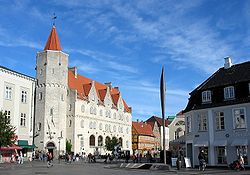 |
|||
|
|||
| Nickname(s): "Paris of the North", locally "Double A" | |||
| Motto: "Seize The World" , In Danish "Vild med Verden" | |||
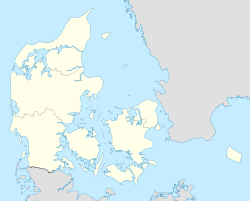 Aalborg
|
|||
| Coordinates: | |||
| Country | |||
| Region | North Denmark Region | ||
| Municipality | Aalborg Municipality | ||
| First mention | "Alabu" written at coins from 1035 | ||
| Officiel birthday | Trade rights June 16, 1342 | ||
| Government | |||
| - Mayor | Henning G. Jensen (S) | ||
| Area[1] | |||
| - Urban | 139 km2 (53.7 sq mi) | ||
| - Municipal | 1,144 km2 (441.7 sq mi) | ||
| Elevation | 5 m (16 ft) | ||
| Population (2010)[2] | |||
| - City | 123,432 | ||
| - Density | 888/km2 (2,299.9/sq mi) | ||
| - Municipal | 197,426 | ||
| - Municipal Density | 173/km2 (448.1/sq mi) | ||
| - Demonym | Aalborggenser | ||
| Time zone | Central Europe Time (UTC+1) | ||
| Postal codes | 9000, 9008, 9020, 9100, 9200, 9210, 9220, 9400 | ||
| Website | http://www.aalborg.dk/engelsk/ | ||
Aalborg or Ålborg (Danish pronunciation: [ˈʌlb̥ɒːˀ] (![]() listen)) is a Danish industrial and university city in North Jutland. Its population, as of 2010, is 197,426,[2] making it the fourth largest city in the country after Copenhagen, Århus, and Odense. The earliest settlements date back to around AD 700. Its location by the Limfjord made it an important harbour during the Middle Ages, and an industrial centre later. Today, the city is in transition from a working-class, industrial, city to a knowledge-based one.
listen)) is a Danish industrial and university city in North Jutland. Its population, as of 2010, is 197,426,[2] making it the fourth largest city in the country after Copenhagen, Århus, and Odense. The earliest settlements date back to around AD 700. Its location by the Limfjord made it an important harbour during the Middle Ages, and an industrial centre later. Today, the city is in transition from a working-class, industrial, city to a knowledge-based one.
Contents |
History of Aalborg
Early age

Aalborg traces its history back over 1000 years. It was originally settled as a trading post, because of its position on the Limfjord. The sites of what were two settlements and a visible burial ground can be seen on Lindholm Høje, a hill overlooking the city. The size of these settlements emphasise the significance of this place as a crossroads. The first mention of Aalborg under its original name Alabu, is found on a coin dated to 1040. An alternative spelling is Alebu and an approximate translation of the name is The (dwelling) place by the stream.

Middle Ages
During the Middle Ages, Aalborg prospered and became one of the largest cities in Denmark. This prosperity was further enhanced when in 1516 Aalborg was granted a monopoly in salt herring. The herring fishery linked Aalborg to the East coast of England, across the North Sea, both in commercial competition and cultural exchange. The panelled interior from an Aalborg house in the National Museum, Copenhagen (illustration), shares many details with Jacobean panelled rooms.
Aalborg received town privileges in 1342 and the bishopric dates from 1554.
World War II
During the German invasion of Denmark in 1940, the Aalborg Aerodrome was captured by German paratroopers very early in the action and Aalborg is said to be the first city ever to be captured by paratroopers. The aerodrome was crucial for German aircraft to be able to reach Norway.
Geography

Distances
Aalborg is located 120 kilometres north of Aarhus, 82 kilometres north of Randers and 50 kilometres north of Hobro. Aalborg is located 50 kilometres south of Hjørring, 63 kilometres south west of Frederikshavn and 90 kilometres east of Thisted. There are 414 kilometres (by Great Belt Fixed Link) to Copenhagen. There are 450 kilometres to Hamburg in Germany. To Gothenburg in Sweden there are (by the Frederikshavn-Göteborg ferry) 150 kilometres. To Oslo in Norway there are 340 kilometres (by the Hirtshals-Oslo ferry).
Climate
Summers in Aalborg have average high temperatures of around 20 °C (68 °F) and lows of 12 °C (54 °F), but temperatures sometimes exceed 25 °C (77 °F) and occasional heatwaves are common during the summer.
Winters usually have temperatures of −3 to 2 °C (27 to 36 °F), rarely dropping below −10 °C (14.0 °F).
| Climate data for Aalborg | |||||||||||||
|---|---|---|---|---|---|---|---|---|---|---|---|---|---|
| Month | Jan | Feb | Mar | Apr | May | Jun | Jul | Aug | Sep | Oct | Nov | Dec | Year |
| Average high °C (°F) | 2 (36) |
2 (36) |
5 (41) |
10 (50) |
15 (59) |
19 (66) |
20 (68) |
20 (68) |
16 (61) |
12 (54) |
7 (45) |
3 (37) |
10.9 (51.6) |
| Daily mean °C (°F) | 0 (32) |
0 (32) |
2 (36) |
6 (43) |
11 (52) |
14 (57) |
16 (61) |
16 (61) |
12 (54) |
9 (48) |
4 (39) |
1 (34) |
7.5 (45.5) |
| Average low °C (°F) | −3 (27) |
−3 (27) |
−1 (30) |
2 (36) |
6 (43) |
10 (50) |
12 (54) |
11 (52) |
9 (48) |
6 (43) |
2 (36) |
−1 (30) |
4.0 (39.2) |
| Precipitation mm (inches) | 54 (2.13) |
35 (1.38) |
44 (1.73) |
38 (1.5) |
49 (1.93) |
54 (2.13) |
64 (2.52) |
67 (2.64) |
72 (2.83) |
76 (2.99) |
75 (2.95) |
62 (2.44) |
689 (27.13) |
| Avg. precipitation days | 11 | 8 | 10 | 8 | 9 | 8 | 9 | 10 | 12 | 13 | 14 | 12 | 124 |
| Sunshine hours | 39 | 72 | 117 | 167 | 209 | 218 | 209 | 186 | 130 | 87 | 57 | 42 | 1,534 |
| Source: DMI (Danmarks Meteorologiske Institut)[3] | |||||||||||||
Transport
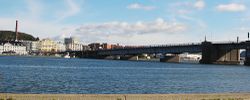
On the north side of the Limfjord is Nørresundby, which is connected to Aalborg by a road bridge Limfjordsbroen, an iron railway bridge Jernbanebroen over Limfjorden, as well as a motorway tunnel running under the Limfjord Limfjordstunnelen.
Public transportation

The city has one main train station Aalborg Banegård, close to J. F. Kennedy-Square. Other stations in Aalborg are Skalborg Station, Aalborg Vestby Station and Lindholm Station. The inner city as well as the wider urban area is served by regular busses running frequently most of the day. Aalborg Airport is located 6 kilometres from the city centre.
Car transportation
The European route E45, going from Finland to Italy, passes through Aalborg, and through Limfjordstunellen under the Limfjord in Aalborg.
Air transportation
Aalborg Airport is the local airport with 20 routes to European destinations.
Aalborg Air Base—an important base of the Danish Air Force is located in Aalborg.
Port of Aalborg
The Port of Aalborg is northern Denmark’s main import/export hub.[4]
Visitor attractions
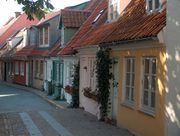
Historical attractions
The old Aalborghus Castle (Aalborghus Slot) and some picturesque houses of the 17th century remain in the center of the town. The half-timbered (bindingsværk) castle was built in 1550 by King Christian III, and was converted to government administration offices in the 1950s.

Jens Bang's House, a five story building built in 1624 by the merchant Jens Bang is an example of Renaissance architecture. It is located on Nytorv next to the old Town Hall.
The present Budolfi Church dates from the end of the 14th century, although at least two earlier churches stood on the same spot. Budolfi Church was just a parish church until it became the seat of the Lutheran bishop of Aalborg in 1554.
Vor Frue Kirke ("Church of Our Lady") is a relatively modern church. The original Church of Our Lady from the early 12th century was pulled down after the Reformation because it was so old and unstable. The newer building in a different location was partially burned in 1894.
Underneath the main pedestrian shopping street is a newly opened museum of the excavation of a monastery from the 11th century.
Nørresundby is the site of the Lindholm Høje settlement and burial ground from the Germanic Iron Age and Viking times. There is also a museum on the site.
Aalborg Historical Museum is located in the city.
Newer attractions

Aalborgtårnet is a tripod tower erected in 1933. The tower's height, 105 m (344.49 ft) over sea level, still gives an exquisite view over the fjord and the city.
The Aalborg Zoo was opened in 1935 and typically houses over 1200 animals.[5]
Near the Aalborg Tower is KUNSTEN Museum of Modern Art Aalborg. The art museum was designed by the Finnish architect Alvar Aalto and built in 1972.
In 2008, the Utzon Center, dedicated to the work of the noted architect Jørn Utzon, was built next to the Limfjord at the central harbour front in Aalborg. Born in Copenhagen, Utzon grew up in Aalborg. The center contains an exhibition on Utzon's work, which includes the Sydney Opera House, as well as educational displays on architecture and design.
Nordkraft is a cultural centre in a former power plant near the harbour. It has theatres (opening in 2010), a cinema, and concert facilities. In its neighbourhood, a classical concert hall, Musikkens Hus, designed by Coop Himmelb(l)au, is planned.
Jomfru Ane Gade
One of the most popular and famous streets in Aalborg, possibly even in Denmark, is Jomfru Ane Gade, or simply just Gaden ("The Street"). The name translates to "Virgin Ane's Street" in English.
Jomfru Ane Gade is a café and restaurant street during day which, at night, turn into clubs, discos and bars. During the 1990s the street was infamous for being a 'hang out' of two biker gangs who were at war for some years all over Scandinavia, but as the bikers disappeared from the street it became even more popular among people of all ages.
During the day, tourists and employees in the city come to Jomfru Ane Gade, especially for its restaurants. In the afternoons some of the cafés open. Around 11 pm the mood of the street changes into more of a party street when younger people arrive.
Aalborg Carnival
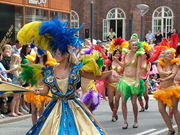
The annual Aalborg Carnival takes place in the weekend of week 21 (usually the last week in May).[6] The Carnival is actually three events, the children's carnival (Børnekarneval), the battle of carnival bands, and the carnival itself. During the carnival, Aalborg receives about 100,000 people. The children's carnival is a carnival dedicated to the children, with performances and activities for children. On Friday "The Battle of Carnival Bands" is an exciting and colourful evening with processions through the city when all the participating groups compete to be the leading carnival group.
The carnival itself is the following Saturday – on this day the city centre is full of life. The streets are filled with gaily dressed people who are in a real spring mood. In Kildeparken concerts are given from various stages all day to midnight. The Carnival ends with a grand firework display.
Sport
Aalborg BK
The city is home to the Danish sports club Aalborg BK, established in 1885 and known as "AaB" for short. The major division in Aalborg Boldspilklub is football division AaB Fodbold, which competes in the Danish Superliga championship. They play their games at Energi Nord Arena. The club has won the Danish Superliga in the 1994–95 season, the 1998–99 season and the 2007–08 season. The team qualified for the group stages of the 1995–96 and 2008–09 UEFA Champions League seasons.
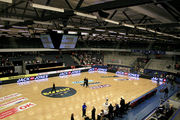
Other clubs
Aalborg is also known for the women's handball club Aalborg DH. They are established in 2001 and play their games in Gigantium. This City also has a Cricket club named Aalborg Cricket Club that is part of Danish Cricket League. They are established in 2000 and have players from various nations.
Education
University of Aalborg

The major college in Aalborg is the University of Aalborg, founded in 1974. It has more than 14,000 students and more than 2,000 employees.[7]
Other colleges
Aalborg Business College, Tech College Aalborg, Royal School of Library and Information Science, University College of Northern Denmark and Trænregimentet.
One of the two colleges of Profession School University College North Jutland (Danish: Professionshøjskolen University College Nordjylland) can also be found in Aalborg.
Industry
Aalborg is still an industrial and commercial centre in Denmark, exporting grain, cement and fish. Many of the traditional industries in the city have been closed in recent years and new knowledge based industries have arisen. Especially mobile and wireless communications industries has been dominant in Aalborg since the 1990s.
Traditional industries
Aalborg is home to De Danske Spritfabrikker's ("Danish Distillers") akvavit snaps, production facility for the distillation of the Aalborg family of akvavits consisting of 17 different brands. Danish Distillers is Scandinavia's largest producer and supplier of spirits for consumption, and is the world's largest producer and exporter of akvavit, supplying over 140 geographic markets.
Aalborg Industries, the world's largest manufacturer of marine boilers, is headquartered here.
Modern industries
It is the centre of telecommunications industry originating from the University of Aalborg.
Religion
Aalborg is the seat of a bishop within the Danish National Church.
Environmentalism

The First European Conference on Sustainable Cities and Towns took place in Aalborg, in 1994. The Conference adopted the Aalborg Charter <http://ec.europa.eu/environment/urban/pdf/aalborg_charter.pdf>, which provides a framework for the delivery of local sustainable development, and calls on local authorities to engage in Local Agenda 21 processes.
The 4th European Sustainable Cities and Towns Conference ("Aalborg +10": http://www.aalborgplus10.dk/), held in Aalborg in 2004, adopted the Aalborg +10 Commitments. These commitments are an important step forward in turning sustainable urban development from words into real actions.
International relations
Twin towns — sister cities
Aalborg maintains cultural, economic and educational ties with 27 cities around the globe.[8] Thus, Aalborg has the most twin cities in Denmark. Every four years Aalborg gathers youth from the majority of its twin cities for a week of sports games, known as Ungdomslegene (The Youth Games).
|
Notable people
Born in Aalborg
- John of Denmark, Norway, and Sweden, King of Denmark, Norway and Sweden
- Søren Lodberg Hvas, Bishop of Aalborg diocese
- Preben Kaas, actor and comedian
- Henning Munk Jensen, footballer
- Henning Jensen, footballer
- Ebbe Sand, footballer
- Britta Thomsen, Danish politician and Member of the European Parliament
- Hanne Dahl, Danish politician and Member of the European Parliament
- Helle Michaelsen, Playboy playmate
- Benny Nielsen, butterfly swimmer
- Jens Larsen, volleyballer
- Joachim Olsen (31 May 1977), shot putter
- Peter Gade, badminton player
- Anne Van Olst, dressage rider
- Camilla Dallerup, ballroom dancer
- Lone Drøscher Nielsen, wildlife conservationist
- Malene Espensen, glamour model
Longer residence in Aalborg
- Jens Munk (1579–1628), navigator and explorer
- Frederik Ferdinand Tillisch (1801–1889), Danish statesman
- Jørn Utzon, architect grew up in Aalborg
- Bjørn Lomborg, statistician and author grew up in Aalborg
- Bent Flyvbjerg, researcher at Oxford University longer engagement at Aalborg University
- Frank Jensen, politician and former Danish Minister grew up in Aalborg
- Ole Stavad, politician and former Danish Minister educated in Aalborg
See also
- Category Aalborg
- Category Neighbourhoods in Aalborg
- Category Towns and settlements in Aalborg Municipality
- Category Aalborg Municipality
References
Notes
- ↑ Statistik om Folketal 2009 statistics from Aalborg Municipality
- ↑ 2.0 2.1 BEF44: Population 1 January, by urban areas database from Statistics Denmark
- ↑ "Weather Information for Aalborg" (in Danish). Danmarks Meteorologiske Institut. http://www.dmi.dk/dmi/index/danmark/klimanormaler.htm. Retrieved May 12, 2009.
- ↑ Aalborg Havn
- ↑ About the Zoo. Aalborg Zoo. Accessed on July 2, 2010.
- ↑ Aalborg Carnival
- ↑ "Aalborg University: History – Aalborg University". en.aau.dk. http://en.aau.dk/About+Aalborg+University/History. Retrieved 2009-10-08.
- ↑ "Aalborg Kommune – Venskabsbyer". Web.archive.org. 2007-11-14. http://web.archive.org/web/20071114155748/http://www.aalborgkommune.dk/Borgerportal/Serviceomraader/Byen/Venskabsbyer/Towns.htm. Retrieved 2009-07-26.
- ↑ "Edinburgh – Twin and Partner Cities". © 2008 The City of Edinburgh Council, City Chambers, High Street, Edinburgh, EH1 1YJ Scotland. http://www.edinburgh.gov.uk/internet/city_living/CEC_twin_and_partner_cities. Retrieved 2008-12-21.
- ↑ Kaliningrad information
External links
![]() Chisholm, Hugh, ed (1911). "Aalborg". Encyclopædia Britannica (Eleventh ed.). Cambridge University Press.
Chisholm, Hugh, ed (1911). "Aalborg". Encyclopædia Britannica (Eleventh ed.). Cambridge University Press.
- Satellite image from Google Maps
- About Aalborg from Nordjyske Medier (A local Media Group)
- Aalborg Kommune (Aalborg Municipality's official website)
- VisitAalborg (Aalborg Tourist Office)
- Aalborg University in English
- Aalborg University in Danish (Danish)
- Aalborg Cricket Club
- Public Transport in Aalborg and surroundings (Danish)
- Aalborg Akvavit
- Ålborgtårnet (Danish)
- Aalborg Carnival Information
|
|||||||||||||||||
|
|||||||||||||||||||||||||||||||||||||||||||||||||||||||||||||||||||
|
|||||||||||||||||||||||||||||||||||||||||||||||||||||||||||||||||||||||||||||||||||||||||||||||||||||||

